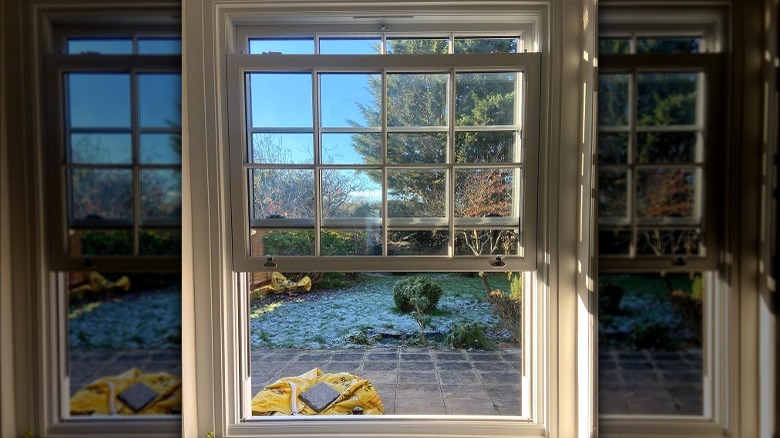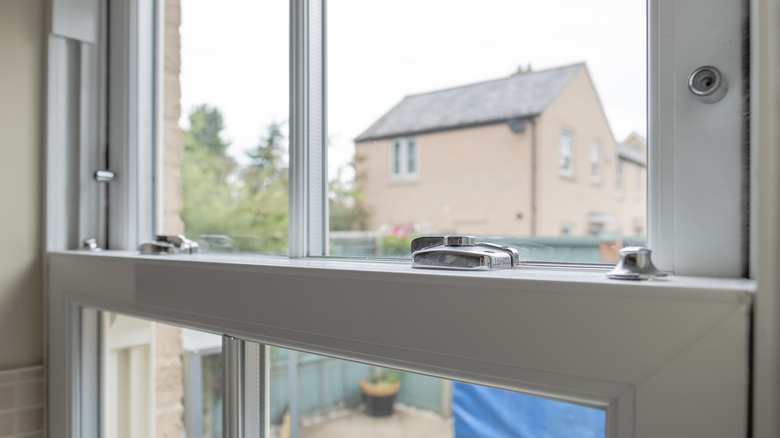What Is A Window Sash And Why Do You Need One?
If you're the kind of person who likes to learn a little bit about everything, here's a tidbit of knowledge that might come in handy for trivia night: In the most general sense, a window sash is the portion of the window that slides up to open and down to close. It's comprised of several parts like glass panels, rails, and stiles, but the whole sliding unit itself is typically called a sash. Today, it's very common for homes and apartments to have window sashes. They're especially important to have if you want to be able to open a window for ventilation, but they can also be a vital escape route in an emergency.
This slide-up style is sometimes referred to as a "sash window" or "double-hung" window, and although it seems like a mundane feature, sash windows actually have a fascinating history. Even though they were first invented hundreds of years ago, sash windows still have a lot of modern applications and advantages over other window styles. Here's what you need to know about the history, purpose, and benefits of a sash window.
Looking through panes of history
It's difficult to say exactly when and where sash windows originated, but many speculate the design appeared in Europe sometime around the 17th century. Sash windows quickly spread across many European countries, including France, Holland, and England, and they remained the go-to style for window architecture until after World War II. Sash window designs were also influenced by their surroundings and popular architecture at the time, with Georgian, Victorian, and Queen Anne windows each offering a distinct look.
At some point during the mid-20th century, sash windows fell out of style in favor of new hinged casement windows. Casement windows were much easier and cheaper to produce, and they could also be fitted with trendy stained glass and art nouveau designs.
No matter their aesthetic appearance, sash windows are a sum of the same functioning parts: a fixed upper panel and a sliding lower panel, each made up of stiles and rails, also known as mullions. Originally, sash windows were built with pegs or notches to hold the window open, but the design eventually transitioned to use counterweights and pulleys, which hid inside the window frame and allowed the user to quickly throw up the sash. Today, modern sash windows have mostly abandoned the pulleys and now have a spiral balance or spring system to hold the window up using tension.
Modern advantages of sash windows
Aside from a sash window, some other common window styles today include horizontal sliding windows, casement windows, hopper windows, and awning windows. Sash windows and sliding horizontal windows operate in much the same way, except sliding windows move from side to side, and don't typically offer as large an opening. Casement, hopper, and awning windows also have limited opening abilities. Casement windows hinge from their side and are usually small and lightweight so as not to overstress the hinges. Hopper and awning windows hinge from the top and bottom, respectively, so they can't usually swing open very wide.
Historically, sash windows were a monumental invention because they allowed more sunlight and fresh air to come into the home. In the age of electricity, we don't depend on natural light as much, but sash windows are still good to have for a variety of reasons. For one, it's pleasurable to throw open a window on a beautiful sunny day, and the wide size of sash windows allows for good airflow plus a screen to block insects and dust. Letting a good breeze pass through your home is incredibly important when household air pollution causes an estimated 3.2 million deaths per year (via the World Health Organization), and sash windows can also be a wise choice for emergency safety. In the tragic event of a housefire, a sash window provides an easy escape that could even save your life.


